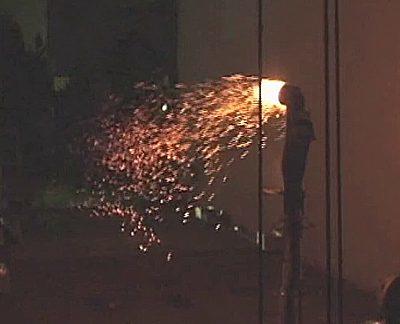Summary
Wildland fires that spread into urban areas, termed Wildland-Urban Interface (WUI) fires, are becoming more and more common across multiple locations of the world. The 2018 WUI fires in the US state of California demonstrated the shear destruction that WUI fires are capable of by destroying more than 18,800 structures and resulting in multiple fatalities. An important component in rapid spread of WUI fires are the production or generation of new, far smaller combustible fragments from the original fire source referred to as firebrands. Firebrands signifies any hot object in flight that are capable to ignite other fuel types. Firebrands are produced or generated from the combustion of vegetative and structural fuels. Firebrand processes include generation, transport, deposition, and ignition of various fuel types, leading to fire spread processes at distances far removed from the original fire source. While the term ember has been used to sometimes indicate the same connotation as firebrand, these terms are in fact slightly different. For WUI fires, the production of firebrands occurs from the combustion dynamics of vegetative and man-made fuel elements, such as homes. As part of this detail extension, a two tiered approach will be developed: (1) fundamental understanding of firebrand processes in WUI fires that will aid in validating WUI fire models and (2) more applied research investigations that may be directly transferred to develop new standard testing methodologies. As part of the success of the ongoing detail to Japan, both full-scale and reduced-scale firebrand generators have been developed to aid in the understanding of these processes. These are housed in wind facilities in Japan. Yet, further new experimental methodologies will be developed as part this new detail extension and new three year project.
Description

Objective - To reduce the risk of structural ignition during a wildland-urban interface (WUI) fires by developing the technical basis for new and improved standard laboratory test methods and building codes considering WUI fire hazards.
What is the new technical idea? An approach to reduce ignition of structures in urban fires has long been the development and adoption of building codes and standards. These guidelines provide the basis for fire resistant construction in many of the developed countries throughout the world. In the United States, for example, such codes and standards have been in existence much longer for urban fires, while WUI fire building codes and standards are far newer, due to the more recent WUI fire problem in this country. It is therefore not surprising that WUI fire codes and standards remain largely unproven to actually mitigate WUI fire spread and structure ignition processes. The problem is simply due to the fact that WUI fire science is much less developed than more mature areas of fire safety science. The missing WUI fire science is being developed as part of this effort through the development of entirely new measurement science using unique wind facilities in Japan.
What is the research plan? During the combustion process of vegetative fuels, pyrolysis of the fuel elements is an important mechanism. For conifer tree combustion, fuel elements consist of needles, bark, and branches. During the combustion of vegetative fuel elements, these pyrolysis reactions result in the generation of gases and vapors and also act to weaken the structural integrity of the original fuel source itself as a result of the mass loss processes. As these combustion processes occur during WUI fires, the application of aerodynamic forces from the interaction of wind forces imposed by the atmospheric boundary layer to vegetative fuel elements results in the breakage of small elements, that once lofted, become firebrands. Firebrand generation from structure combustion is also an important mechanism to generate firebrands in WUI fires. Firebrand generation from structure combustion remains unsolved, and no rigorous modeling attempts have been made, as compared to some limited models for vegetative fuels.
Many factors influence the firebrands generated from structure combustion. These complex physical processes will be studied in FY21 using wind facilities in Japan. Fundamental experiments will be undertaken of firebrand generation processes with wind on vegetative fuel sources to determine firebrand production fluxes, mass loss profiles, heat flux profiles. Additional experiments on structural fuels sources to determine firebrand production fluxes, mass loss profiles, heat flux profiles will also be undertaken.
In parallel with experiments focused on the fundamental of this physical processes, work will also continue in applied areas necessary to address the WUI problem. ISO TC92/Task Group (TG) 03 (Large Outdoor Fires and the Built Environment) was formed to advise ISO TC92 on a path forward for the topic Large Outdoor Fires and the Built Environment. As result of ISOTC92/TG03 activities, including a workshop at the ISO TC92 Plenary meetings in Delft on October 2018, and a subsequent special section of papers from this workshop guest edited in the journal Fire Technology, the task group proposed the formation of a new working group (WG) under TC92. This new working group (WG), entitled ISO TC92/WG14 (Large Outdoor Fires and the Built Environment) has been formally approved with Manzello as convener. The current charge of is to develop the technical report ISO TR/24188: Large Outdoor Fires and the Built Environment – Global Overview of Different Approaches to Standardization. Additional work items are in discussion, including the development of new WUI fire standards, under the large outdoor fire umbrella, including the the development of an ISO standard firebrand generator.
ISO TC92 WG14 is working closely with the permanent working group, known as Large Outdoor Fires and the Built Environment (LOF&BE), established by the International Association for Fire Safety Science (IAFSS) to bring the full depth of knowledge from the entire IAFSS community to the large outdoor fire problem.

